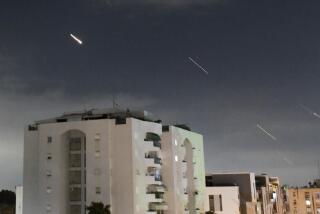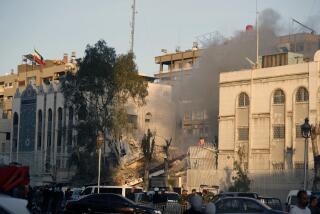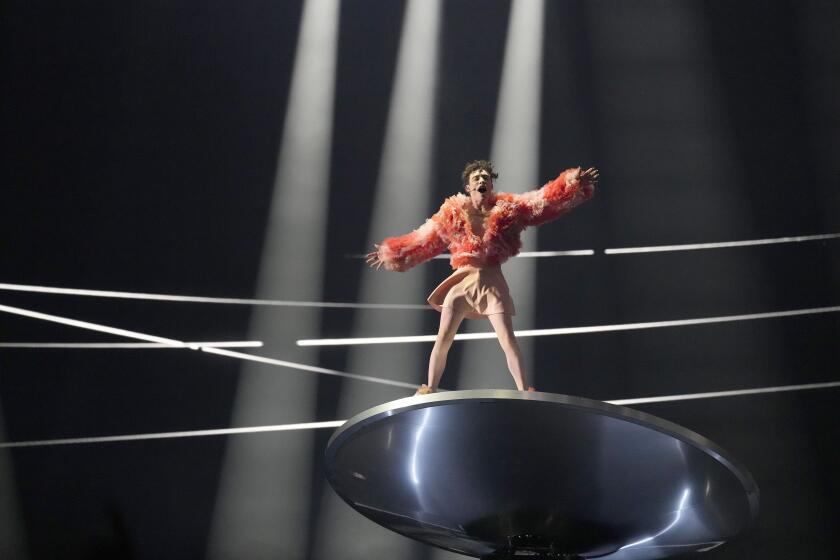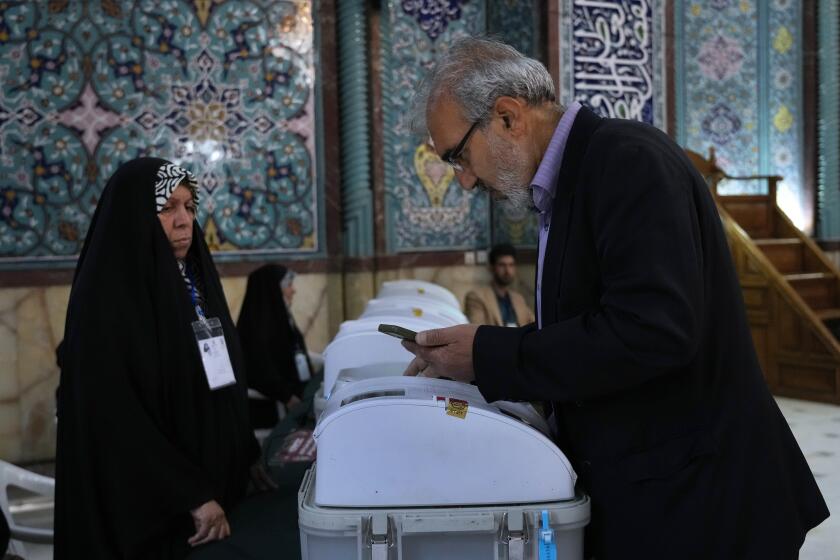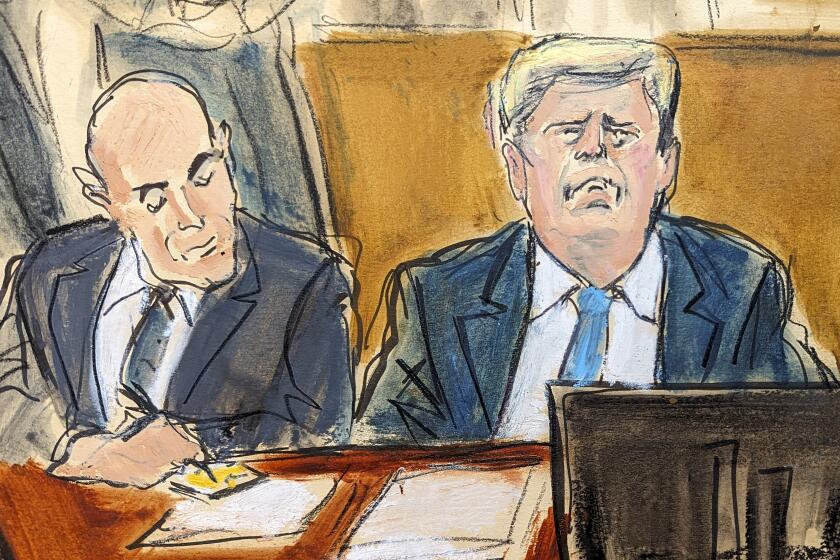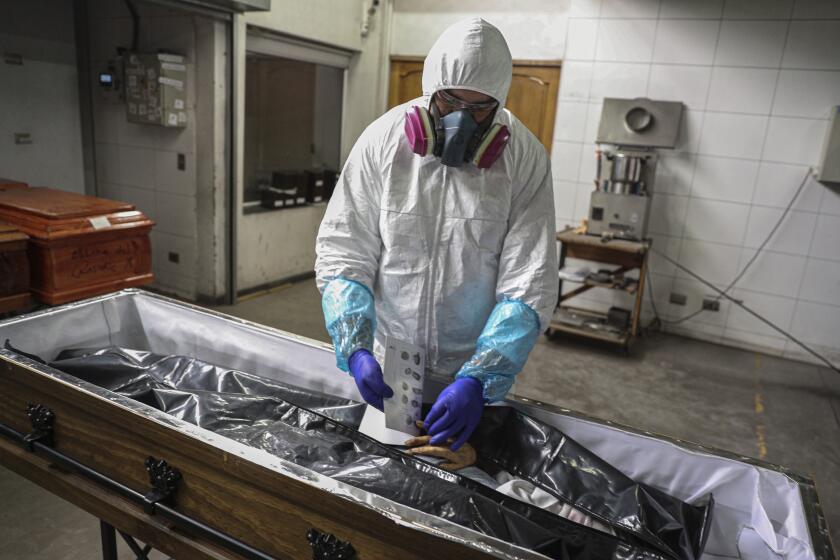Hezbollah Exchanging Terror for Engagement : Mideast: The group has been blamed for recent bombings, but experts say most members work on political, economic and social programs.
A little more than a decade after its emergence unleashed one of the deadliest waves of extremism ever witnessed in the Middle East, Lebanon’s Hezbollah is going legit.
Once a clandestine movement with unknown leaders, Hezbollah now is a legal political party and part of the largest bloc in Lebanon’s Parliament.
Once heard from only via anonymous phone calls and unsigned communiques, it now communicates through a small media empire including two television and four radio stations.
Once a political and financial subsidiary of Iran, it now conducts public fund-raisers at home and abroad, collects taxes from its faithful and reflects a growing diversity of political views.
Once associated with suicide bombings and kidnapings, it now runs one of the largest social welfare programs in Lebanon, costing tens of millions of dollars and, in some ways, outdoing the state.
The transformation, which has occurred over the past two years, reflects a classic pattern of evolution by radical groups from terrorism to participation in the political systems they have been trying to bring down.
Recent history is littered with examples: Menachem Begin’s Irgun in Israel in the 1940s; Jomo Kenyatta’s Mau Mau in Kenya in the 1950s; Mozambique’s Frelimo in the 1970s; Colombia’s M-19 in the 1980s. Most recently, Palestine Liberation Organization guerrillas evolved from Israel’s nemesis into its partners in peace, governing Jericho and the Gaza Strip.
Hezbollah’s transformation is far from complete. Authorities on four continents link bombings in Argentina, Panama and Britain last month to a militant cadre in one of Hezbollah’s many wings.
But counterterrorism officials and Middle East experts estimate that as much as 80% of Hezbollah--Arabic for the Party of God--is now engaged in legal political, economic and social programs.
“Hezbollah metamorphosed into much more than a terrorist group or militia. Only a small number, proportionately, are hard-core terrorists,” said Bruce Hoffman, co-director of the Center for Terrorism and Conflict Studies at St. Andrews University in Scotland. “Probably less than 1,000 are on the front lines of terror.”
Since Hezbollah emerged in the early 1980s under Iran’s patronage, most of the Shiite Muslims attracted to it have been lured less by its fiery rhetoric than by its social services, from health care to farming cooperatives to subsidized taxis. Its activism contrasted conspicuously with the collapsed Lebanese government.
In Lebanon’s eastern Bekaa Valley, its initial stronghold, Hezbollah runs a several-hundred-bed hospital that treats as many as 25,000 patients a month. It has put the less impressive state hospital out of business. It also offers low-cost or free medical care in Beirut and southern Lebanon, and not only for Shiites.
Divided into political, cultural, social and military branches, Hezbollah is organized into disciplined committees that have dug wells--at up to $160,000 apiece--in farmland and delivered water to rural shanties and urban refugees. Hezbollah workers have extended electricity to new areas and provided fuel to the needy in winter. They have built new roads and rebuilt old schools.
They even picked up garbage in south Beirut for four years until the city took over. The party also subsidizes thousands of Shiite families, who after decades of discrimination by Maronite Christians and Sunni Muslims tend to be Lebanon’s poorest.
“In large areas of Lebanon, where the government is nowhere to be seen, Hezbollah has filled the vacuum,” said a Western diplomat long based in Beirut. “Tens of thousands of Lebanese are now dependent on Hezbollah for basic services that most citizens would normally get from the state.”
More startling yet is the shift in Hezbollah’s political strategy.
Despite its singularly vitriolic rhetoric, the Party of God has always been a confederation of diverse political and religious strains. The gap has recently widened.
The first turning point was Lebanon’s 1992 parliamentary election, the first in 20 years after a civil war had killed more than 120,000 people. After months of tortuous debate and consultations with Iran, Hezbollah decided to field candidates.
“It did astonishingly well,” remarked a U.S. official who witnessed the polling. In a country where political parties reflect the 17 recognized religions, the Party of God won eight of 128 seats. With four seats won by other Islamist candidates, Lebanon’s Islamist bloc became the largest in Parliament.
Hezbollah abruptly changed course a second time last April, when it bowed to government pressure and turned in 11 of its own people for demonstrating illegally. They served brief jail terms for possessing unlicensed weapons, according to Western envoys.
Putting the state before its own people was unprecedented. Some analysts even suggest that it marked the beginning of the end for Hezbollah’s militia--the only one in Lebanon still allowed to bear arms, on the grounds that it is fighting Israel’s presence in Lebanon. The Beirut-based diplomat called the recent terrorist attacks “part of the last hurrah.”
The decision to work within the system rather than challenge it from outside was far from unanimous. Militants charged that accepting the state and its structures, including rules allotting power to other religions, meant forfeiting any hope of establishing an Islamic state in Lebanon.
The transition underscores a raging internal battle over identity. “While the leadership is moving more and more to a pragmatic mode, it also wants to maintain militias as long as possible,” the envoy said. “The party sees the writing on the wall but is trying to delay the inevitable.”
Two increasingly disparate trends are now visible in six Hezbollah wings, according to Lebanese and U.S. experts. The split is most personified by two clerics.
The first is Sheik Hassan Nasrallah, 35, Hezbollah’s secretary general and one of its founders. He is from agricultural south Lebanon and received religious training in both Iraq and Iran.
Initially considered a militant because of ties to Hezbollah’s militia, he has converted an underground religious movement into a legal political party--although some analysts say that the shift was due more to Iranian direction than to his leadership.
“Hezbollah is as much political as it is military,” he pronounced after his election as party secretary general. Militants charge that he abandoned “revolutionary purism.” Defenders accuse critics of “childish leftism.”
The second is Sheik Sobhi Tufeili, 45, the party’s firebrand first leader who was replaced in 1990. Hezbollah’s leadership is virtually handpicked by Iran, experts say, and Tufeili fell out of step with changes in Iran’s leadership and strategy, which was then heading toward release of American and French hostages in Lebanon.
Since then, Tufeili has symbolized Hezbollah’s most militant wing. Some U.S. analysts believe he heads Ansar al Allah, the Partisans of God faction that claimed responsibility for the recent Buenos Aires and Panama bombings.
But other Mideast experts caution against obsessions with titles.
“The name is as fictitious as Islamic Jihad and Organization of the Oppressed on Earth, which were used at the end of the 1980s,” said Asad AbuKhalil, a Lebanese-born political scientist and expert on the Shiites at California State College, Stanislaus. “To pay attention to a name can be confusing. The names are used to distract attention from Hezbollah.”
Tufeili favors military action and opposes accepting the secular Lebanese state and playing the role of a party in politics.
“We do not work or think within the borders of Lebanon . . . which is one of the legacies of imperialism,” he said in the late 1980s. “We must eliminate the artificial entity known as Lebanon.”
In addition to the followers of these two leaders are three smaller Hezbollah cells:
* A tight-knit group that claimed to be Islamic Jihad and several other groups in the 1980s. It centers on Imad Mughniyah, secretly indicted in the United States for several American hostage seizures, and Abdu Hadi Hamadi, whose two brothers are jailed in Germany for a hijacking and hostage taking. The group is close to Tufeili and is linked with many of Hezbollah’s deadliest deeds, including the bombings of two U.S. embassies and American and French military compounds.
* Dawa, or the Call, the offshoot of an Iraqi dissident group. It folded into Hezbollah in the 1980s and provided the clerical backbone. Now reportedly disillusioned with the mainstream, it is again moving out on its own.
* The Faithful Resistance founded by Mustafa Dirani, whose abduction by Israel in June is seen as a motive for Hezbollah’s alleged new bombings. He is close to Tufeili and Mughniyah but has an independent power base.
Finally, there is also Sheik Mohammed Hussein Fadlallah, who emerged from scholarly obscurity to be Hezbollah’s spiritual mentor. His followers include intellectuals and gunmen, independents and members of all Hezbollah wings.
Right-wing Christian militia sources claimed Fadlallah blessed two suicide bombers before they drove into the U.S. and French military compounds a decade ago, a claim investigators never proved.
The next step in Hezbollah’s evolution depends on progress toward peace both within Lebanon and between Israel and its Arab neighbors.
“Hezbollah’s fortunes will decline as there is no need for resistance,” AbuKhalil said. “The peace process could mean its end. . . .”
Others predict that Hezbollah will survive as a political force.
“Both Hezbollah and the other Islamists are here to stay,” the envoy said. “But they are narrowly entrenched. There are built-in limitations about how far they can go. And once there is peace, their ability to flourish will be seriously strained.”
Wright reported from Washington, Murphy from Beirut.
More to Read
Start your day right
Sign up for Essential California for news, features and recommendations from the L.A. Times and beyond in your inbox six days a week.
You may occasionally receive promotional content from the Los Angeles Times.

